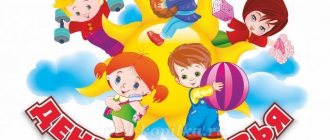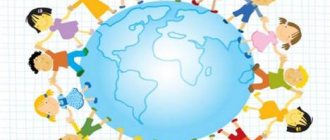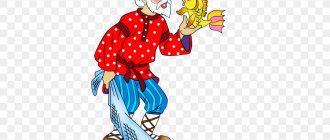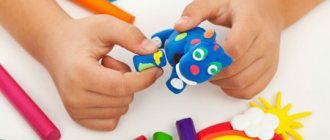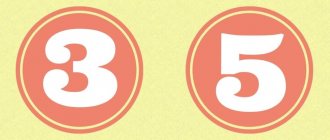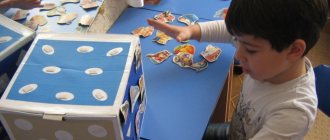The didactic game “Say it in one word” is intended for preschoolers of the older age group. It helps to consolidate terms that are generalizing for several objects on several topics: “Animal world”, “Flora world”, “Transport”, “Clothing”, “Housing” and others. Through play, a child learns to think, build logical chains, explain opinions, classify, his horizons and personal vocabulary expand.
Didactic games
"Guess the toy"
Goal:
to develop the ability to find an object, focusing on its signs and actions.
The adult shows the child 3-4 toys, he names them. You must immediately teach how to correctly name an object: “This is... (hare, fox, duckling).” An adult talks about each toy, naming external signs: “This is a soft toy. She's gray. The tail is short and the ears are long. He loves carrots and jumps smartly.” Other toys are described in a similar way, the child names them.
"Who am I talking about"
Goal:
to develop observation skills, the ability to focus on the main features of the described object.
The adult describes the child sitting in front of him, naming the details of his clothing and appearance, for example: “This is a girl, she is wearing a skirt and blouse, her hair is blond, her bow is red. She loves to play with the Tanya doll.”
"Tell me which one"
Goal:
learn to identify and name the characteristics of an object.
The adult takes objects out of the box, names them (“This is a pear”), and the child names the signs (“It’s yellow, soft, tasty.” “This is a tomato.” - “It’s red, round, ripe, juicy.” “This is a cucumber.” - “It’s... oblong, green, crispy”).
"Correct the mistake"
Goal:
to teach to see the discrepancy between the signs of familiar objects depicted in the picture and to name them.
An adult draws himself or shows a picture and invites the child to find inaccuracies: a red chicken pecks at a carrot; bear cub with hare ears; a blue fox without a tail, etc. The child corrects: the chicken is yellow, pecking at grains; the bear cub has round small ears; The fox has a long tail and a red coat.
“Who will see and name more”
Purpose:
to highlight and denote with words the external characteristics of an object.
An adult and a child examine the doll, name items of clothing and appearance (eyes, hair). Then the bunny comes. They say that he has a gray (soft, fluffy) coat, long ears, in one word you can say: the hare is long... ukhy (long-eared). And the hare’s tail is... (short), which means it is short-tailed. The cat is smooth, fluffy, her paws are white, which means she is... white-footed. For correct answers, the doll gives the child flags (ribbons, pyramid rings).
“What did Pinocchio mess up?”
Goal:
find errors in the description and correct them.
Pinocchio comes to visit the child with his friend the duckling. When talking about his friend, Pinocchio makes mistakes and admits inaccuracies in the description, for example: “The duckling has a blue beak and small paws, he shouts “meow!” “The hare has small ears and is green.” “The cat has a prickly coat.” The child corrects inaccuracies.
"What a doll"
Goal:
to learn to name various signs of the appearance of a toy or object.
The adult says that the doll was called ugly, and she was upset. We need to help her and tell her everything about her, how beautiful she is. - Who is this? (Doll.) What is she like? (Elegant, beautiful.) What can Tanya do? (Play, draw, sing, dance.) Let's talk about Tanya together. The adult begins: “Our Tanya... (the most beautiful). She has... (an elegant red dress, a white bow, brown shoes, white socks).” From naming visible and bright features (color, shape, size), you need to move on to listing the properties, internal qualities of an object, its characteristics, comparisons (for example, in the game “Who will say more words about an apple, what kind of apple is it, and what kind of orange?”; “ Compare an orange and an apple. How are they similar and how are they different?”).
"Compare the dolls"
Goal:
to teach children to correlate objects with different characteristics.
An adult offers to look at two dolls and say how they differ. The child gives the dolls names (Katya and Tanya) and says: Tanya has light and short hair, Katya has dark and long hair, Tanya has blue eyes, Katya has black eyes, Tanya is in a dress, and Katya is in trousers, the dolls have different clothes. - The dolls wanted to play, they took... (balls). This ball... (round, rubber, blue, small). And the other ball... (big, red). What can you do with balls... (throw, throw, catch, toss, toss)? - Look at this ball. It is larger than blue, but smaller than red. What is he like? (Average.)
"Compare the bears"
Goal:
to teach to distinguish objects (toys) by characteristic features.
An adult offers to look at two bear cubs of different colors: one is black and large, the other is brown and small. - Tell me who they are and how they differ. One bear is big, he is black. - What can you call him so that you can see that he is black? (Blackie.) What can he do? (Growl, eat raspberries, honey, run.) - How to name another bear so that it is clear that he is small? (Baby.)
“Compare different animals”
Goal:
learn to compare different animals, highlighting opposing characteristics.
The teacher suggests looking at a bear and a mouse. - The bear is big, and the mouse... (small). What kind of bear... (fat, thick-footed, club-footed)? And what kind of mouse... (small, gray, fast, dexterous)? What Mishka loves... (honey, raspberries), and the mouse loves... (cheese, crackers). - Mishka’s paws are thick, and the mouse’s... (thin). The bear screams in a loud, rough voice, and the mouse... (in a thin voice). Who has the longest tail? The mouse has a long tail, and Mishka... (short). Similarly, you can compare other animals - the fox and the hare, the wolf and the bear. Based on visualization, children learn to name words with opposite meanings: the Katya doll is big, and Tanya... (small); the red pencil is long and the blue one... (short), the green ribbon is narrow and the white one... (wide); one tree is tall and the other... (low); Katya's doll's hair is light, and Tanya's... (dark). Children develop an understanding and use of general concepts (a dress, a shirt are... clothes; a doll, a ball are toys; a cup, a plate are dishes), develop the ability to compare objects (toys, pictures), relate the whole and its parts (locomotive, pipes, windows, cars, wheels - train). Children are taught to understand the semantic relationships of words of different parts of speech in a single thematic space: a bird flies, a fish... (swims); they are building a house, soup... (cooking); the ball is made of rubber, the pencil... (of wood). They can continue the series of words they started: plates, cups... (spoons, forks); jacket, dress... (shirt, skirt, trousers). On the basis of clarity, work is carried out and familiarization with polysemantic words (chair leg - table leg - mushroom leg; handle on a bag - handle on an umbrella - handle on a cup; sewing needle - needle on a hedgehog on its back - needle on a Christmas tree).
“Features of developing hard work in older preschoolers”
Ministry of Education and Science of the Russian FederationFederal State Budgetary Educational Institution of Higher Education"Chechen State Pedagogical University"Faculty of Correspondence StudiesDepartment of Pedagogy and Preschool Psychology"To Defense"
Head department PiDP
_________Z.I.Gadaborsheva
"___" ____________2018 GRADUATE QUALIFYING WORK
(qualification – bachelor)
Topic: “Features of developing hard work in older preschoolers” Completed by: student
Directions 03/44/01 –
Teacher Education,
profile - "Preschool education".
| ____________ | Umkhazhieva M. | |
| Supervisor | ____________ | Gebekova A.N. |
| Consultants: | ||
| 1.Analytical part | ____________ | Gadaborsheva Z.I. |
| 2. Practical part | ____________ | Gebekova A.N. |
| Norm controller, hands. UMU | ____________ | Khataeva R.S. |
| The project is protected for evaluation _______________________________ | ||
| Protocol No.________ “_____”________________ 2017 | ||
| Secretary of the State Attestation Commission | ____________ | Mavlokhadzhieva A.A. |
Grozny, 2018
Contents Introduction________________________________________________________________3 Chapter 1. Theoretical foundations of the problem of developing hard work in older preschoolers_________________________________________________7 1.1. General characteristics of a preschooler’s work activity ________7 1.2. Social and pedagogical prerequisites for the need to instill hard work in preschool children___________________________14
1.3 Content of labor education in kindergarten MBDOU No. 125 “Smile”__________________________________________________________18
Conclusions on Chapter I_____________________________________________26 Chapter 2. Experimental work on developing hard work in older preschoolers using the example of MBDOU No. 125 “Smile”___________28 2.1. Characteristics of the system of pedagogical activities for the formation of hard work in older preschoolers in MBDOU No. 125 “Smile” ________________________________________________________________28 2.2. Comparative analysis of the results of experimental work on the formation of hard work in older preschool children in MBDOU No. 125 “Smile”______________________________________________________________40 Conclusions on Chapter 2_____________________________________________46 Conclusion_______________________________________________________________48 References___________________________________________51 Appendix ________________________________________________54 Introduction
Analyzing preschool age as the basic stage of development of personal qualities, the concept of lifelong education defines the essence of a new approach to preschool education in connection with the implementation of federal state educational standards of preschool education, based on the principles of variable content, pedagogy of development, and a preschooler’s knowledge of the world through the types of activities that interest him and organize him. A mechanism has been developed that subordinates the quality of preschool education to the state standard - criteria for assessing the activities of preschool institutions; conceptual foundations of preschool education. At the same time, the concept draws attention to the development of personal qualities necessary for the further development of the individual: curiosity, initiative, communication, creative imagination, arbitrariness.
Despite all this, the concept does not include the task of instilling hard work. Meanwhile, a number of indicators of hard work (awareness of the goal of activity and perseverance in achieving it; readiness to complete the work begun; manifestation of an emotionally positive attitude towards work; positive assessment of the results of activity; accuracy, diligence, careful attitude to the means and products of labor) are most successfully formed in preschool and primary school age in the works of such teachers as R.S. Bure, G.N. Godina, M.V. Krulekht, V.I. Loginova, T.A. Markova, V.G. Nechaeva, D.V. Sergeeva and others.
The lack of development of these qualities at this age stage becomes an obstacle to educational and cognitive activity during training at the primary level and subsequent adaptation to independent work. The importance of labor as a factor in the development of a child’s personality is reflected in the works of such domestic teachers as: P.P. Blonsky, N.K. Krupskaya, A.S. Makarenko, V.A. Sukhomlinsky, S.T. Shatsky and others. Theoretical confirmation of the labor education of youth with access to practical recommendations is highlighted in the works of teachers P.R. Atutova, A.A. Akhmatova, S.Ya. Batysheva, K.N. Katkhanova, V.A. Polyakova and others.
The development of a positive attitude towards work in preschool children is influenced by its content, forms, methods of managing work activity and the conditions of its organization, as well as the collective nature of the activity, the formation in children of concepts about adult work, social motives for work, the availability of skills, and the creation of a working atmosphere. The issue of the role of the emotional state of the child in the process of labor activity, a differentiated approach to children in determining methods of influencing the organization, and the formation of labor education on them is considered. The participation of these factors has not been sufficiently studied: the methods and techniques of pedagogical influences do not take into account the changes that occur in the child’s attitude to work, work activity in the process of labor education and work activity; The question of how work has a positive impact on the emotional state of the child and contributes to his further activities has not been sufficiently studied. The pedagogical literature notes that the formation of a child’s attitude towards work is influenced by the level of physical activity, the regularity of children’s participation in work, and the involvement of children in self-care. Thus, despite the variety of works exploring the problem of labor education, the issues of comprehensive substantiation of pedagogical conditions for creating a positive attitude towards work have not been sufficiently resolved. The systematic inclusion of each child in work, the correct work schedule, the creation and maintenance of a positive emotional state of the child at all stages of work can cause children to have a constant desire to work. And a gradual change in types of activities will ensure on this basis the formation of a positive attitude towards work and work activity.
Thus, the relevance of the study determined the topic of our final qualifying work “Features of the formation of hard work in older preschoolers”
0.81 Mb.
Share with your friends:
